Our Products

HEAT TREATED GLASS
Heat treated glass refers to the process normal annealed float glass is put through to enhance its intrinsic strength to turn them into tempered or heat-strengthened glass.
TUFLITE
A tempered glass that is manufactured by first heating the cut to size glass in the furnace to around 650°C to bring it to a plasticised state. It is then conveyed to the cooling section and rapidly quenched in cold air through a series of high pressure air nozzles blowing onto the top and bottom of the glass.
This process creates a high compressive layer on the glass surface with the core remains in tension due to the rapid cooling on its surface. These added stresses in the glass increase the thermal and mechanical strength of the glass without changing the physical characteristics of the glass.
Tuflite is a safety glass , 4 to 5 times greater than that of float glass of the same thickness. In the unlikely event of any breakage, it will shatter into small blunt like particles, significantly reducing the risk of serious injury.
Tuflite glass can withstand a temperature differential of up to 250°C making it the perfect product for areas where high thermal stress is a concern.
HEAT-SOAKED PROCESS
Tempered glass suffers risk of spontaneous breakage, a phenomenon associated with nickel sulphide presence in the glass. Heat soak test was then developed to detect the presence of such nickel sulphide inclusions in tempered glass. Nickel sulphide inclusions are formed when nickel that finds their way into the glass batch and sulphur from the fuel oil used to fire the furnace combine during the manufacturing process to form “stones” in the molten glass. These “stones” are often very small and not visible. In its annealed state these nickel sulphide inclusions do not pose any problems.
During the glass toughening process, the nickel sulphide inclusions are transformed into a different phase. This phase transformation causes its volume to increase. This volumetric expansion puts stress on the glass surrounding the nickel sulphide inclusion leading it to spontaneously break. These breakages may not occur immediately, it may take several years (solar heat cycles).
Heat soak test is done by heating the tempered glass to an elevated temperature of around 290oC and soaked it for several hours to accelerate the volumetric expansion of the nickel sulphide inclusions. This raises the probability that should there be inclusions, the glass will break during the process in the factory rather than in situ. The heat soak process can only reduce the risk of spontaneous breakage due to Nickel Sulphide inclusions but cannot eradicate it.
CGT incorporates heat soaking in all its Tuflite glass.
Tempered glass fracture pattern |
Typical tempering process line |
 |
|
SEMI-TUFLITE
A heat-strengthened glass that is manufactured in the same way as Tuflite except it is gradual sequential cooling rather than rapid cooling. This result in a glass that has twice the strength of a normal float glass but about half that of tempered glass.
It has a similar fracture pattern as float glass but in smaller fragment. It is not prone to spontaneous breakage and with its added strength it is the ideal choice for high rise curtain-wall design especially on spandrel areas where added strength against thermal stress is needed.

LAMINATED GLASS
Laminated glass is a safety glass, manufactured by adhering two or more pieces of glass together with a flexible interlayer. The interlayer is generally either a PVB (poly vinyl butyral) or a CIP (resin). The glass and interlayer are bonded together using heat and pressure in an autoclave. Virtually all glass types can be laminated and the thickness and type of interlayer can be altered to provide security, energy efficiency, acoustic and decorative solutions.
SHATTERPRUF
A laminated glass in annealed, heat-strengthened (Semi-Tuflite) or tempered(Tuflite) combinations incorporating the vast range of glass products that CGT distributes. Available in PVB, EVA, SGP interlayers that hold the pieces of glass together and will not shatter or splinter onto the ground when breakage occurs.
Laying out glass in clean room |
Typical laminating process line |
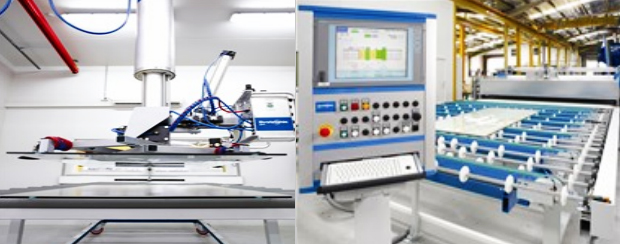 |
|
An Insulating Glass Unit (IGU) is made up of 2 or more layers of glass separated by spacer bar filled with desiccant and hermetically sealed with primary and secondary sealant. IG units improve significantly thermal/acoustic performance and reduce interior condensation in cold weather providing a high level of comfort. A wide variation or configuration of glass can be incorporated in an IGU to satisfy a wide range of aesthetic, thermal and acoustic requirements. Introduction of argon gas into the air space will further enhance the overall performance of the IGU.
INSULITE
An insulating glass unit combining 2 or more panes of glass separated by desiccant filled hollow aluminum spacer bar hermetically sealed with primary polysiobutylene and secondary silicone sealant. A wide arrays of glass combination can be obtained to provide security, energy efficiency, acoustic and decorative solutions.
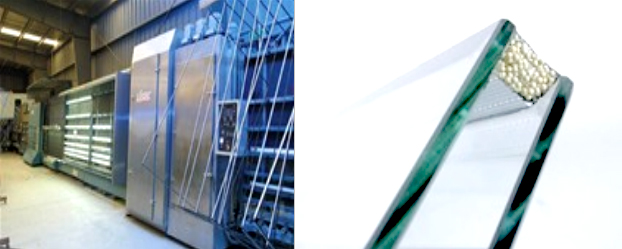 |
|
Typical Insulating Glass Process Line |
Insulating Glass Unit |

FLOAT GLASS
Float glass is manufactured through a process developed by Pilkington in 1959, taking flat glass technology to a revolutionary new level. The glass gains its lustrous finish and perfect flatness by floating on a bath of molten tin in a chemically controlled atmosphere. The ribbon of glass is then cooled, while still moving, until the surfaces are hard enough for it to be taken out of the bath without the roller marking the surface. The glass is then automatically cut and stacked, ready to be packed for distribution.
The Float Line
- Raw material feed
- Sand, soda ash, dolomite, limestone and a proportionate amount of cullet are combined to form a batch. Strict quality controls and monitoring of temperatures throughout the process maintain high quality standards.
- Furnace
- Batch materials are fed into the furnace. Full melting is achieved at around 1600°C.
- Float bath
- A continuous ribbon of molten glass floats along the surface of molten tin. Irregularities are melted out, ensuring flat, parallel surfaces in the glass.
- Annealing lehr
- The glass is annealed and gradually cooled to 200°C, to relieve stresses and prevent splitting and breaking in the cutting phase.
- Cutting
- The glass ribbon is cut automatically as it moves along the rollers.
- Stacking and offloading
- A series of automatic stackers offload the glass. The glass is then warehoused for distribution, using overhead cranes and mobile lifting vehicles.
OPTIK
Float glass in clear and wide range of tint through CGT vast network of manufacturers to provide a one stop solution to developers, consultants to satisfy their increasing needs for range of particular tint choices that no one manufacturer alone could meet. Tint series and ranges are carefully selected for its distinctive quality, affordability and availability.
Clear are available in 3mm, 4mm, 5mm, 6mm, 8mm, 10mm, 12mm, 15mm, 19mm and stock size of 72" x 48", 96" x 72", 120" x 84", 144" x 96" and 160" x 120".
Tints are available in shades of green, blue, blue-green, grey, bronze in 5mm, 6mm, 8mm, 10mm, 12mm.
PERFORMANCE
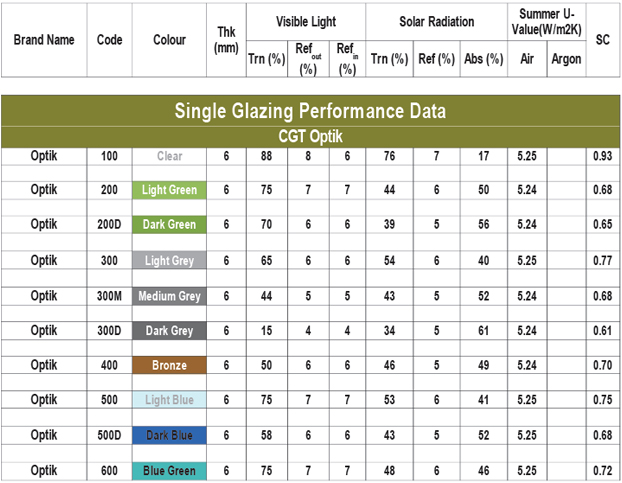
Please click here for a Video Clip on Float Glass Manufacturing.
HIGH PERFORMANCE TINTED GLASS
High performance tinted glass provides far superior solar performance as compared to normal tinted glass. It is manufactured by selectively reducing the infra-red and UV spectrum which is the heat and color fading components of the light spectrum while enhancing that of the visible part through the glass. Color is richer with low exterior reflectance and natural view from interior coupled with the reduced heat gain makes it an ideal choice for residential, commercial, industrial, schools, institutional windows application.
ECO
A high performance tint available in green, blue and grey.
Eco Green
A rich natural green tint with high daylight transmittance and good solar control having a shading co-efficient of 0.52, it offers more than 20% better solar performance than any other green tint in the world.
Eco Blue
A lively and unique blue tint engineered for high light transmittance, soothing color and good solar control. It provides a subtle, non disrupted natural view from the interior.
Eco Grey
With a shading co-efficient of 0.41, the grey tint provides the best solar control of any uncoated float glass. The deep color tone greatly reduces see-through providing daytime privacy from outside while maintaining a soothing interior view from inside. With significantly reduced glare, working near computer monitors close to windows or looking up skylights will no longer be a painful experience to the eyes.
PERFORMANCE
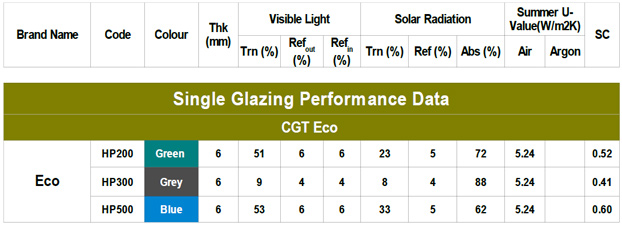
Please consult us for any other thickness and combination.
REFLECTIVE GLASS
Reflective glass provides thermal and solar control enhancement by reflecting the sun's radiation away. It is manufactured by depositing a thin layer of metallic coating onto the surface of glass. This metallic coating not only shields the heat but also renders a shine giving the building a glittering and modern look. There are 2 modes of manufacturing – Pyrolytic/on line coating and Sputtering/off line coating.
PYROLYTIC/ON LINE COATING

Pyrolytic is an on line chemical vapour deposition process whereby a gas reacts with the semi molten glass surface along the tin float bath area of the float glass manufacturing line to form a thin layer of metallic coating. The coating deposit is literally fused onto the glass surface making it highly durable and resistant to scratch/damage. It is commonly known as hard coat reflective glass. Classified as a primary glass products, it is available in standard stock sheets like all other primary glass products such as clear, tinted float glass. Can be easily cut and further process at downstream processing plants into tempered, laminated, insulating glass finished products.
REFLITE
A hard coat reflective glass made using the chemical vapour deposition process (CVD). Reflite reduces the load on the cooling system by reflecting about 30-60% of the sun's energy. Coating surface can be on the outside or inside. With coating on the outside, building aesthetic will be more silvery and glittering. On the inside, the tonality of the substrate glass will be more pronounced. Energy cost saving of 25% or more as compared to using uncoated glass of the same thickness.
SPUTTERING/OFF LINE COATING
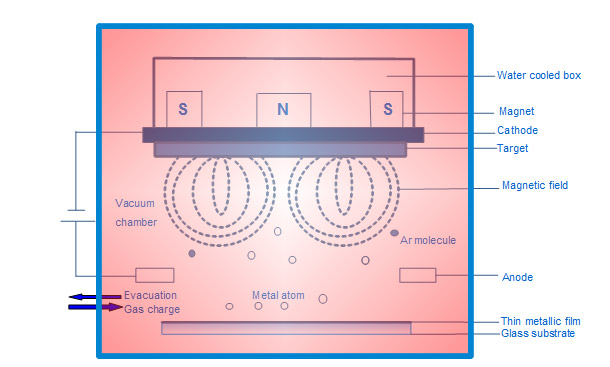
Sputtering is an offline coating process where the glass substrate is fed into a vacuum chamber under a controlled electrolytic environment. Under a charged argon gas atmosphere, metal atoms from cathode target material are drawn towards the anode glass surface forming a thin uniform layer of coating. With different metal targets and varying charged atmosphere, a wide hues of color can be achieved providing a vast spectrum of choices for consultants, developers and homeowners. Coating is durable but must be placed on the inside. It is commonly known as soft coat reflective glass and classified as a secondary or downstream glass product.
REFSHINE
A soft coat reflective glass using the sputtering process. Refshine significantly reduces interior cooling load with energy cost saving of 35% or more compared to uncoated glass. With its vast range of hues and colors, it allows design flexibility and provides optimal solutions to the various needs of consultants, developers, homeowners.
PERFORMANCE
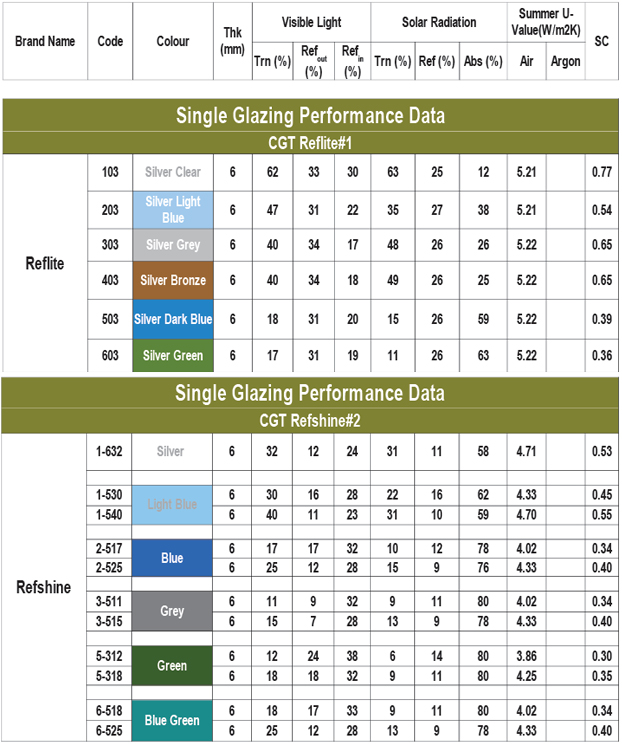
Low-e glass has a low emissivity metallic coating on one side of the glass to increase energy efficiency of windows by reducing the transfer of heat through glass. It works by filtering off the sun's short wave radiation while resisting the heat flow of the long wave radiation to provide optimal comfort to the interior. There are 2 modes of manufacturing- Pyrolytic/On line coating and Sputtering/Off line coating.
PYROLYTIC/ON LINE COATING

Pyrolytic is an on line chemical vapour deposition(CVD) process whereby a gas reacts with the semi molten glass surface along the tin float bath area of the float glass manufacturing line to form a thin layer of metallic coating. The coating deposit is literally fused onto the glass surface making it highly durable and resistant to scratch/damage. It is commonly known as hard coat low-e glass. Classified as a primary glass products, it is available in standard stock sheets like all other primary glass products such as clear, tinted float glass. Can be easily cut and further process at downstream processing plants into tempered, laminated, insulating glass finished products.
SOLAR ADVANTAGE
A family of hard coat low-e glass made using the chemical vapour deposition(CVD) process. Solar Advantage brings to fore the strength of the industry's renowned manufacturers under one roof to provide consultants, developers, homeowners a distinctive range of specific colors where no one manufacturer is able to satisfy. It reduces the load on the cooling system by filtering off about 25-70% of the sun's solar energy while resisting the flow of long wave heat due to temperature difference between the outside and the inside providing optimal comfort to the interior. In tropical climate, coating is best placed exposed to the room side in a monolithic application or no.2 surface of an insulating glass unit.
It is available in clear, green, blue and grey and in cut size or stock size of 130" x 84", 130" x 96" and 126.38" x 88.58".
Please consult us for any size other than indicated.
Solar Radiation Energy Heat Balance Comparison
6mm clear glass
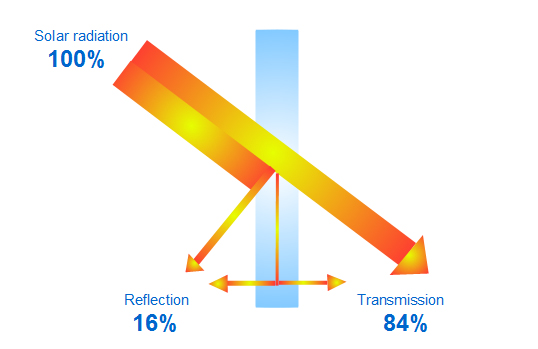
6mm clear Solar Advantage 128 low-e glass
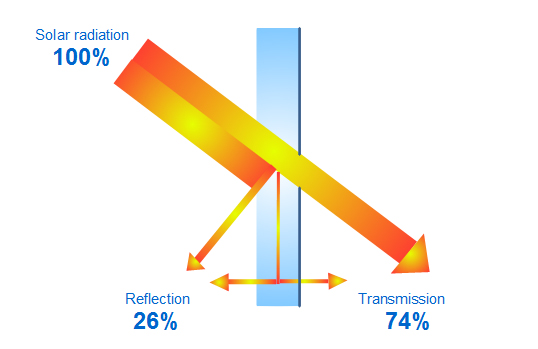
SPUTTERING/OFF LINE COATING
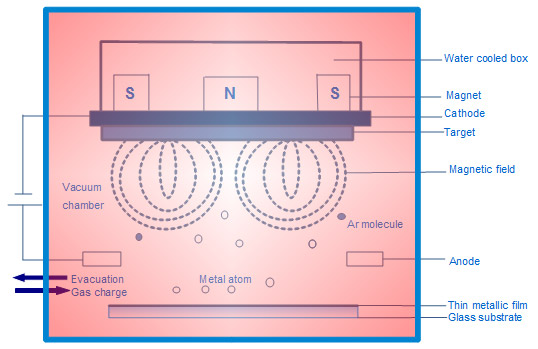
Sputtering is an offline coating process where the glass substrate is fed into a vacuum chamber under a controlled electrolytic environment. Under a charged argon gas atmosphere, metal atoms from cathode target material are drawn towards the anode glass surface forming a thin uniform layer of coating. With different metal targets and varying charged atmosphere, a wide hues of color can be achieved providing a vast spectrum of choices for consultants, developers and homeowners. Coating must be placed on the inside of an insulating glass unit with edge deletion. It is commonly known as soft coat reflective glass and classified as a secondary or downstream glass product.
ELITE ADVANTAGE
A soft coat low-e glass using the sputtering process in an insulating glass unit. Elite Advantage significantly reduces interior cooling load with energy cost saving of 40%-80% or more compared to uncoated glass. With its vast range of hues and colors, it allows design flexibility and provides optimal solutions to the various needs of consultants, developers, homeowners.
Maximum size is 3660mm x 2440mm in clear, green, blue and green.
Please consult us for any size other than indicated.
Solar Radiation Energy Heat Balance Comparison
24mm Insulite clear
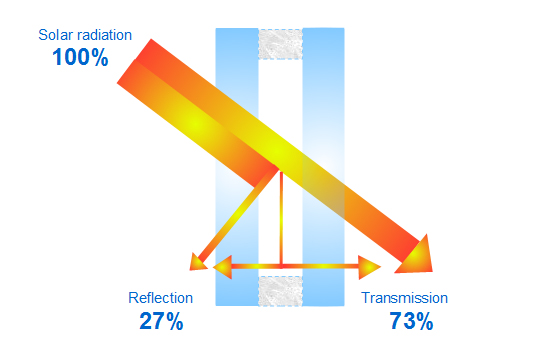
24mm Elite Advantage lnsulite 68/44 clear low-e
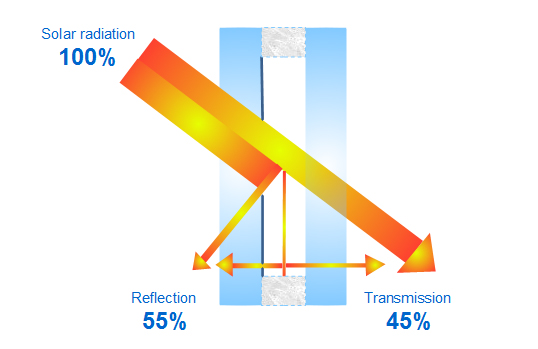
PERFORMANCE
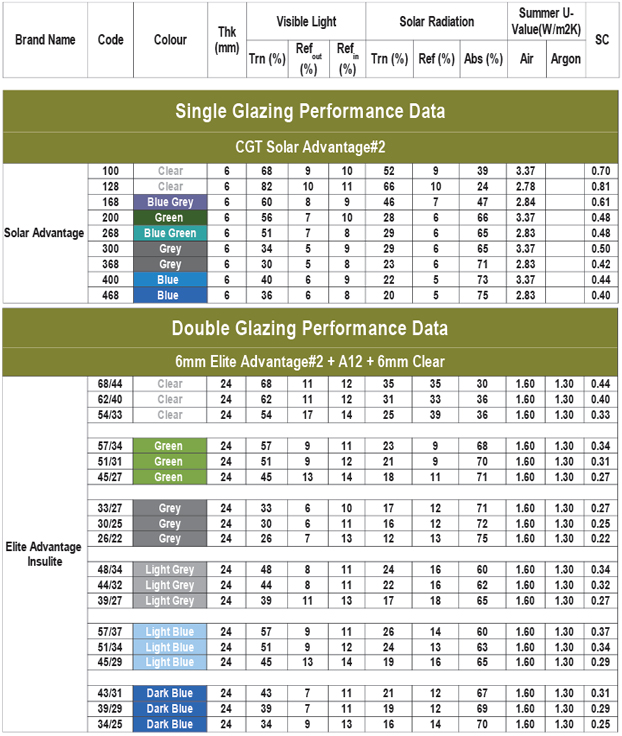
Please consult us for any other thickness and combination.
Reflective Low-e glass has a combination of reflective and low emissivity metallic coating on one side of the glass to increase energy efficiency of windows by reducing the transfer of heat through glass. It works by filtering and reflecting the sun's solar radiation to provide optimal comfort to the interior while giving the exterior a modern shine. It is manufactured using the pyrolytic/on line coating process.
PYROLYTIC/ON LINE COATING

Pyrolytic is an on line chemical vapour deposition(CVD) process whereby a gas reacts with the semi molten glass surface along the tin float bath area of the float glass manufacturing line to form a thin layer of metallic coating. The coating deposit is literally fused onto the glass surface making it highly durable and resistant to scratch/damage. It is commonly known as hard coat low-e glass. Classified as a primary glass products, it is available in standard stock sheets like all other primary glass products such as clear, tinted float glass. Can be easily cut and further process at downstream processing plants into tempered, laminated, insulating glass finished products.
ECLIPSE ADVANTAGE
A hard coat reflective low-e glass made using the chemical vapour deposition(CVD) process. Eclipse Advantage reduces the load on the cooling system by reflecting & filtering off about 25-70% of the sun's solar energy while resisting the flow of long wave heat due to temperature difference between the outside and the inside providing optimal comfort to the interior and glossy exterior. In tropical climate, coating is best placed exposed to the room side in a monolithic application or no.2 surface of an insulating glass unit.
It is available in clear, green, blue, bronze and grey and in cut size or stock size of 130" x 84", 130" x 96".
Please consult us for any size other than indicated.
Solar Radiation Energy Heat Balance Comparison
6mm clear glass
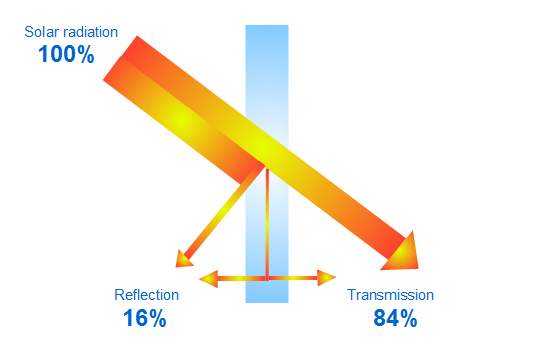
6mm Solar Advantage 128 clear low-e glass
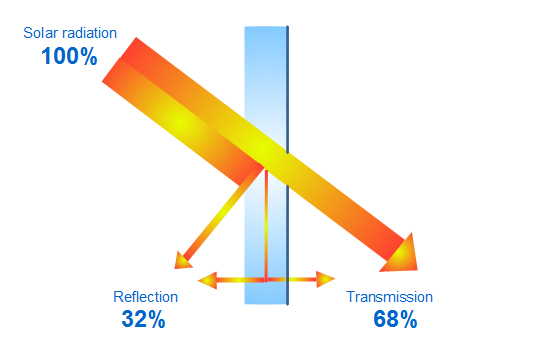
PERFORMANCE
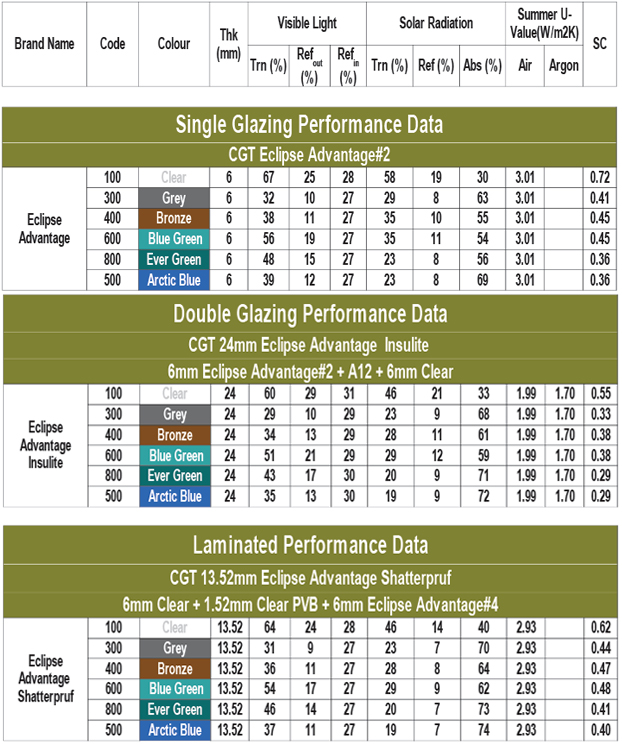
Please consult us for any other thickness and combination
Angle 21 is a sight control glass manufactured by sandwiching a sight control film engineered by Nippon Sheet Glass (NSG) sister company Sumitomo Chemical between 2 sheets of glass. Depending on the viewing angle, glass can be transparent or opaque. There are 3 types to choose from – A, B and C to provide privacy where necessary. Being laminated, Angle 21 is a shatterproof safety glass.
Key Features
- Sight Control
- Three types of ANGLE 21 are available.
- A-Type: Eliminates front view but allows top & bottom view
- B-Type: Eliminates view frpm bottom but allows top view or vice versa
- C-Type: Eliminates top & bottom view but allows front view
- Privacy protection
- ANGLE 21 ensures privacy, offering various options to prevent viewing in any angle. Numerous variations are possible.
- Light Diffusion And Transparency
- The opaque(sight controlled) section of ANGLE 21 diffuses light like frosted glass while the transparent section is as transparent as standard laminated glass.
- Safety
- Like all laminated glass, ANGLE 21 is shatterproof. The lamination provides extra strength to resist glass splinter upon breakage.
- Maximum size
- 1219mm x 3210mm. Please contact us for any other size indicated.
Applications
- Windows and balconies where privacy is required.
- Showcases.
- Decorative display combining the 3 types to create mosaic-like designs.
Project Reference
- Heeren @ Orchard
- UE Square @ Clemenceau Avenue
- Winsland House II @ Penang Road
- Richmond Park @ Elizabeth Link/Bideford Road
- Rosevale @ Lincoln/Surrey Road
- Olivio @ Surrey Road
- Vision Crest @ Oxley Rise
- Dhoby Ghaut Centre @ Dhoby Ghaut Road
Type A
Eliminates front view but allows top & bottom view
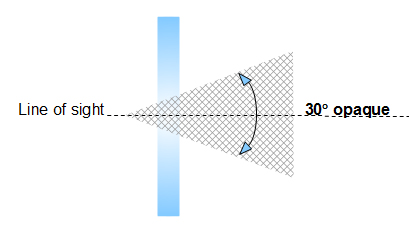
Type B
Eliminates view from bottom but allows top view or vice versa
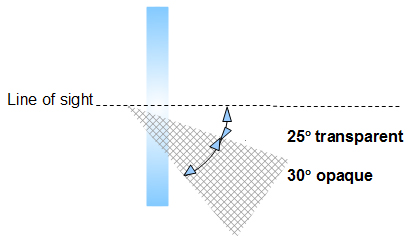
Type C
Eliminates view from top & bottom but allows front view
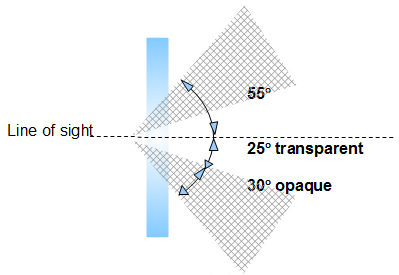
*Notes: All viewing at near window distance position
2000mm distance |
|||
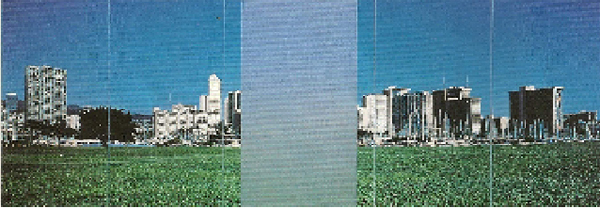 |
|||
| C-Type | A-Type | B-Type | |
1000mm distance |
|||
 |
|||
| C-Type | A-Type | B-Type | |
300mm distance |
|||
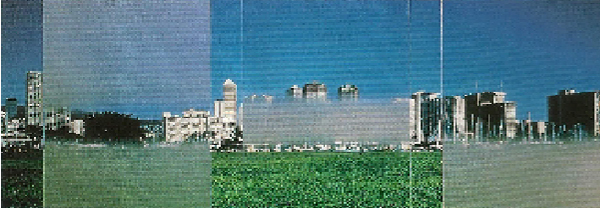 |
|||
| C-Type | A-Type | B-Type | |
SWITCHABLE LIGHT CONTROL GLASS – UMU, is a laminated safety glass made by NSG Japan incorporating a sandwiched liquid crystal sheet that freely transforms the appearance of glass from clear to frosted and vice versa. No more messy curtains and blinds. Meeting rooms, nursery rooms, shower rooms, MRT trains, skylights are all suitable applications for this versatile product that can only be limited by one's own imagination.
Please click here to download the literature.
SELF CLEANING GLASS – ACTIV, made by Pilkington North America uses the force of nature to maintain a cleaner and clearer appearance. In a dual action process, organic dirt is broken down by daylight and is then washed away by rain, thus making it environmentally friendly and very easy to maintain. No more dirty windows, costly maintenance and no more risk to danger of falling out from heights in cleaning window panes. Windows, skylights, canopies are essential areas of applications.
Please click here to download literature.
LOW IRON GLASS – OPTIWHITE, made by Pilkington North America is a specially developed float glass which displays none of the faint bluish/greenish tint in most standard clear glass. Noticeably clearer and more transparent than ordinary standard clear float glass, the pureness and colorlessness is apparent when viewed through its polished edges. It displays products with greater degree of clarity. Shopfronts, car showrooms, display cases, furniture and many more......
Please click here to download literature.
ANTI REFLECTIVE GLASS – OPTIVIEW, developed by Pilkington North America uses its proprietary pyrolitic CVD online manufacturing process to reduce light reflection from a high of 8% in clear glass to less than 2% making viewing through it is like there is no glass. Ideal for museum and retail display and a host of applications where anti reflective glass is never an option.
Please click here to download literature.
FIRE RESISTANT GLASS – PYROSTOP, manufactured by Pilkington Germany is made with a multiple laminate of low-iron float glass and a special transparent intumescent interlayer which when exposed to fire will foam up to form an opaque insulating shield that blocks the heat of the blaze. Up to 120 minutes integrity and insulation is available.
Please click here to download literature.
U-CHANNEL GLASS – PROFILIT, is a unique self supporting cast glass shaped like U-channels made by Pilkington Germany. The U-shaped within the cast glass produces a high structural strength that allows large openings to be enclosed without the need for additional vertical or horizontal support. Its high design flexibility allows many curved radii facade to be met with ease. Up to 6 metres high of uninterrupted translucent or transparent glass wall is now possible. Used in large external glass facade and interior glass wall partition.
Please click here to download literature.
And many more others such as ceramic fritted glass, frosted glass, acid etched glass, figured glass, wired glass etc.
Distributes:




